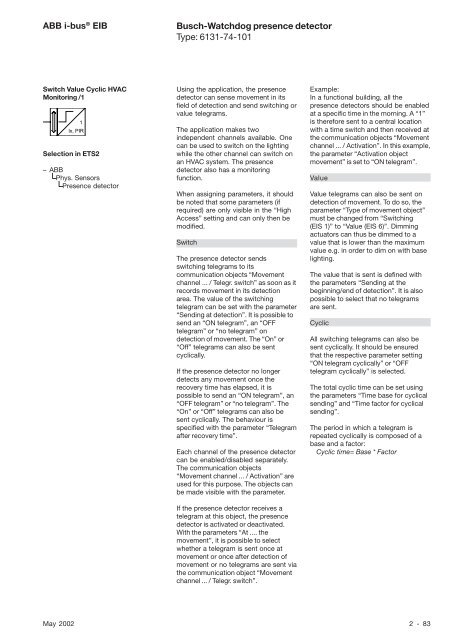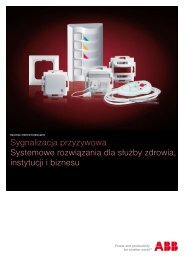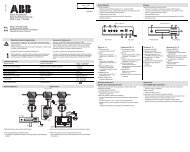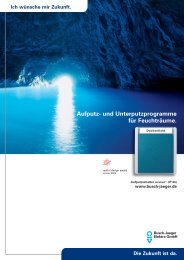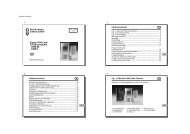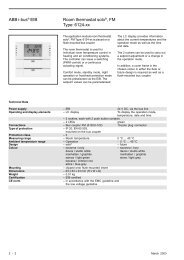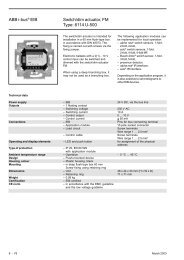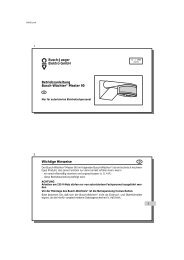Busch-Watchdog presence detector Type: 6131-74-101
Busch-Watchdog presence detector Type: 6131-74-101
Busch-Watchdog presence detector Type: 6131-74-101
- No tags were found...
Create successful ePaper yourself
Turn your PDF publications into a flip-book with our unique Google optimized e-Paper software.
ABB i-bus ® EIB<strong>Busch</strong>-<strong>Watchdog</strong> <strong>presence</strong> <strong>detector</strong><strong>Type</strong>: <strong>6131</strong>-<strong>74</strong>-<strong>101</strong>Switch Value Cyclic HVACMonitoring /1Selection in ETS2– ABBPhys. SensorsPresence <strong>detector</strong>Using the application, the <strong>presence</strong><strong>detector</strong> can sense movement in itsfield of detection and send switching orvalue telegrams.The application makes twoindependent channels available. Onecan be used to switch on the lightingwhile the other channel can switch onan HVAC system. The <strong>presence</strong><strong>detector</strong> also has a monitoringfunction.When assigning parameters, it shouldbe noted that some parameters (ifrequired) are only visible in the “HighAccess” setting and can only then bemodified.SwitchThe <strong>presence</strong> <strong>detector</strong> sendsswitching telegrams to itscommunication objects “Movementchannel ... / Telegr. switch” as soon as itrecords movement in its detectionarea. The value of the switchingtelegram can be set with the parameter“Sending at detection”. It is possible tosend an “ON telegram”, an “OFFtelegram” or “no telegram” ondetection of movement. The “On” or“Off” telegrams can also be sentcyclically.If the <strong>presence</strong> <strong>detector</strong> no longerdetects any movement once therecovery time has elapsed, it ispossible to send an “ON telegram”, an“OFF telegram” or “no telegram”. The“On” or “Off” telegrams can also besent cyclically. The behaviour isspecified with the parameter “Telegramafter recovery time”.Each channel of the <strong>presence</strong> <strong>detector</strong>can be enabled/disabled separately.The communication objects“Movement channel ... / Activation” areused for this purpose. The objects canbe made visible with the parameter.If the <strong>presence</strong> <strong>detector</strong> receives atelegram at this object, the <strong>presence</strong><strong>detector</strong> is activated or deactivated.With the parameters “At .... themovement”, it is possible to selectwhether a telegram is sent once atmovement or once after detection ofmovement or no telegrams are sent viathe communication object “Movementchannel ... / Telegr. switch”.Example:In a functional building, all the<strong>presence</strong> <strong>detector</strong>s should be enabledat a specific time in the morning. A “1”is therefore sent to a central locationwith a time switch and then received atthe communication objects “Movementchannel ... / Activation”. In this example,the parameter “Activation objectmovement” is set to “ON telegram”.ValueValue telegrams can also be sent ondetection of movement. To do so, theparameter “<strong>Type</strong> of movement object”must be changed from “Switching(EIS 1)” to “Value (EIS 6)”. Dimmingactuators can thus be dimmed to avalue that is lower than the maximumvalue e.g. in order to dim on with baselighting.The value that is sent is defined withthe parameters “Sending at thebeginning/end of detection”. It is alsopossible to select that no telegramsare sent.CyclicAll switching telegrams can also besent cyclically. It should be ensuredthat the respective parameter setting“ON telegram cyclically” or “OFFtelegram cyclically” is selected.The total cyclic time can be set usingthe parameters “Time base for cyclicalsending” and “Time factor for cyclicalsending”.The period in which a telegram isrepeated cyclically is composed of abase and a factor:Cyclic time= Base * FactorMay 2002 2 - 83


